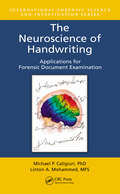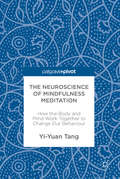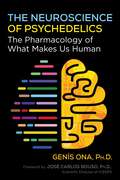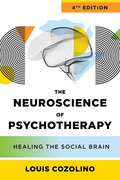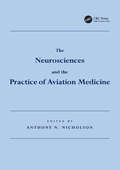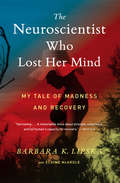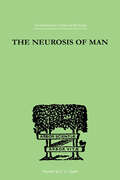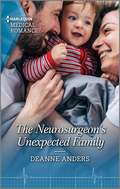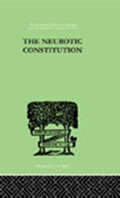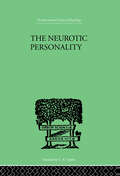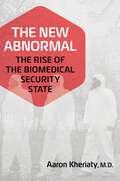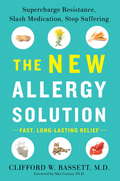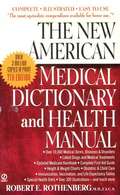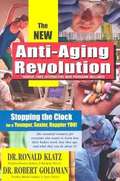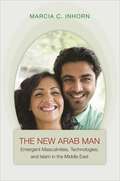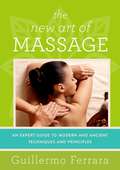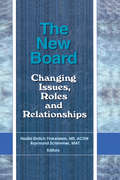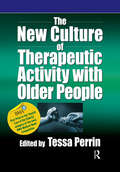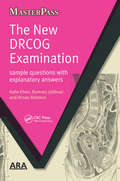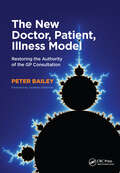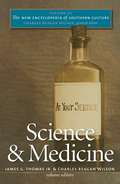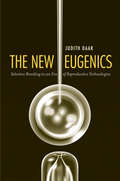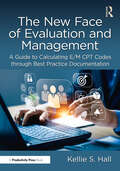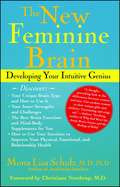- Table View
- List View
The Neuroscience of Handwriting: Applications for Forensic Document Examination (International Forensic Science And Investigation Ser.)
by Michael P. Caligiuri Linton A. MohammedThe Daubert trilogy of U.S. Supreme Court cases has established that scientific expert testimony must be based on science grounded in empirical research. As such, greater scrutiny is being placed on questioned document examination generally, and handwriting comparison in particular. Bridging the gap between theory and practice, The Neuroscience of
The Neuroscience of Mindfulness Meditation
by Yi-Yuan TangThis book presents the latest neuroscience research on mindfulness meditation and provides guidance on how to apply these findings to our work, relationships, health, education and daily lives. Presenting cutting-edge research on the neurological and cognitive changes associated with its practice Tang aims to explain how it reaps positive effects and subsequently, how best to undertake and implement mindfulness practice. Mindfulness neuroscience research integrates theory and methods from eastern contemplative traditions, western psychology and neuroscience, and is based on neuroimaging techniques, physiological measures and behavioural tests. The Neuroscience of Mindfulness Meditation begins by explaining these foundations and then moves on to themes such as the impact of personality and how mindfulness can shape behaviour change, attention and self-control. Finally, the book discusses common misconceptions about mindfulness and challenges in future research endeavours. Written by an expert in the neuroscience of mindfulness this book will be valuable for scholars, researchers and practitioners in psychotherapy and the health sciences working with mindfulness, as well as those studying and working in the fields of neuroscience and neuropsychology.
The Neuroscience of Psychedelics: The Pharmacology of What Makes Us Human
by Genís Ona• Examines the main pharmacological properties of psychedelic substances, including LSD, DMT, psilocybin, ayahuasca, mescaline, ketamine, ibogaine, salvia, and MDMA• Explains the physiological mechanisms behind visionary effects, including what is happening in the brain and how each psychedelic is processed by the body• Shares safe strategies for using psychedelics, including harm-reduction techniques, and looks at where the future of psychedelic therapies is likely to goWith the widespread legalization of marijuana and the increasing use of psychoactives in controlled therapy settings, further research and understanding of psychedelics is now possible. Yet while individual accounts of their use abound, exactly what&’s happening to the brain and body when using these substances is still not widely understood.Longtime pharmacological researcher Genís Ona presents a comprehensive look at the main pharmacological properties of psychedelic substances, including LSD, DMT, psilocybin, ayahuasca, mescaline, ketamine, ibogaine, salvia, tropane alkaloids, and MDMA. Exploring how psychedelics work within the brain, Ona shares results from his extensive research to reveal the physiological mechanisms that allow these molecules to have their visionary effects, explaining what is happening at the receptor level as well as the &“cascade&” effects that differ from substance to substance. He examines how the body processes each substance, describing how each psychedelic is released, absorbed, distributed, metabolized, and eliminated. He also details possible dangerous interactions between these substances and other drugs as well as their potential toxicity.Although his main focus is the biological and neurological effects of psychedelics, Ona also explores the mystical and spiritual dimension of psychedelic use, particularly as practiced in Indigenous traditions, showing how they enable access to a profound spiritual territory. He shares safe strategies for using psychedelics and looks at where the future of psychedelic therapies is likely to go, with an emphasis on ensuring that traditional knowledge is respected, honored, and protected.
The Neuroscience of Psychotherapy: Healing the Social Brain (IPNB #0)
by Louis CozolinoA new edition of the classic text that links neuroscience and human behavior in a therapeutic context. This groundbreaking book explores the revolution in psychotherapy that brought an understanding of the social nature of people’s brains into a therapeutic context. Louis Cozolino is a master at synthesizing neuroscience and demonstrating how it applies to psychotherapy practice. Here, he argues that all forms of psychotherapy are successful to the extent to which they enhance change in relevant neural circuits. Beginning with an overview of the intersecting fields of neuroscience and psychotherapy, this book delves into the brain’s inner workings, from basic neuronal building blocks to complex systems of memory, language, and the organization of experience. In this updated edition, readers will also find new content on the evolutionary foundations of psychotherapy; the necessity of gaining broad perspectives on mind, brain, and culture in clinical training; the importance of interpreting research with the human brain’s biases in mind; the debatable applicability of Eurocentric perceptions of “self”; and more.
The Neurosciences and the Practice of Aviation Medicine
by Anthony N. NicholsonThis book brings the neurosciences to operational and clinical aviation medicine. It is concerned with the physiology and pathology of circadian rhythmicity, orientation, hypotension and hypoxia, and with disorders of the central nervous system relevant to the practice of aviation medicine. The chapters on circadian rhythmicity and orientation deal with the impaired alertness and sleep disturbance associated with desynchrony and with the effects of linear and angular accelerations on spatial awareness. Hypotension and hypoxia cover cerebral function during increased gravitational stress, clinical aspects of exposure to acute hypoxia, the mild hypoxia of the cabin of transport aircraft, adaptation and acclimatization to altitude and decompression at extreme altitudes and in space. Disorders of particular significance to the practice of aviation medicine such as excessive daytime sleepiness, epilepsy, syncope, hypoglycaemia, headache and traumatic brain injury are covered, while neuro-ophthalmology, the vestibular system and hearing also receive detailed attention. The potentially adverse effects of the aviation environment and of disorders of the nervous system are brought together, and the text covers the neurological examination as it relates to aircrew and explores current management and therapeutics. The Neurosciences and the Practice of Aviation Medicine is an essential work for those involved in the practice of aviation medicine where familiarity with the effects of the aviation environment on the nervous system and understanding the pathophysiology of relevant clinical disorders are of prime concern. The authors from leading centres of excellence are physiologists concerned with the aviation environment and physicians involved in the day-to-day practice of medicine. They bring to this authoritative text wide experience and expertise in both the experimental and clinical neurosciences.
The Neuroscientist Who Lost Her Mind: My Tale of Madness and Recovery
by Barbara K. Lipska Elaine McArdleAs a deadly cancer spread inside her brain, leading neuroscientist Barbara Lipska was plunged into madness—only to miraculously survive with her memories intact. In the tradition of My Stroke of Insight and Brain on Fire, this powerful memoir recounts her ordeal and explains its unforgettable lessons about the brain and mind. In January 2015, Barbara Lipska—a leading expert on the neuroscience of mental illness—was diagnosed with melanoma that had spread to her brain. Within months, her frontal lobe, the seat of cognition, began shutting down. She descended into madness, exhibiting dementia- and schizophrenia-like symptoms that terrified her family and coworkers. But miraculously, just as her doctors figured out what was happening, the immunotherapy they had prescribed began to work. Just eight weeks after her nightmare began, Lipska returned to normal. With one difference: she remembered her brush with madness with exquisite clarity. In The Neuroscientist Who Lost Her Mind, Lipska describes her extraordinary ordeal and its lessons about the mind and brain. She explains how mental illness, brain injury, and age can change our behavior, personality, cognition, and memory. She tells what it is like to experience these changes firsthand. And she reveals what parts of us remain, even when so much else is gone.
The Neurosis Of Man: An Introduction to a Science of Human Behaviour (International Library Of Psychology Ser.)
by Burrow, TrigantFirst Published in 1999. Routledge is an imprint of Taylor & Francis, an informa company.
The Neurosurgeon's Unexpected Family
by Deanne AndersFrom single surgeon……to family man?Dr. William Cooper has been truly thrown in at the deep end… His eleven-month-old half sister has been placed into his care and he needs to figure out how to be a surrogate father—quick! So when nurse Hannah Reeves offers to help, William couldn&’t be more thankful. He just didn&’t imagine that the minute Hannah entered his life, he&’d find himself wanting her to be the final piece in his unexpected family! &“This story captivated me. I enjoyed every moment it. This is a great example of a medical romance. Deanne Anders is an amazing writer!&”-Goodreads on The Surgeon's Baby Bombshell&“What an utterly captivating, fast-paced, memorable read Ms. Anders has delivered in this book where the chemistry between this couple is off-the-charts…the dialogue was entertaining and had me hooked from the very beginning and even more so once the hero and heroine come face-to-face….&”-Harlequin Junkie on From Midwife to Mommy
The Neurotic Constitution: OUTLINES OF A COMPARATIVE INDIVIDUALISTIC PSYCHOLOGY and (Select Bibliographies Reprint Ser.)
by Adler, AlfredFirst Published in 1999. Routledge is an imprint of Taylor & Francis, an informa company.
The Neurotic Personality (International Library Of Psychology Ser.)
by Gordon, R GFirst Published in 1999. Routledge is an imprint of Taylor & Francis, an informa company.
The New Abnormal: The Rise of the Biomedical Security State
by Aaron KheriatyThe coronavirus pandemic conferred enormous power on certain government officials. They have no intention of giving it up.In the space of a few weeks in early 2020, Americans witnessed the imposition of previously unimagined social controls by the biomedical security state—the unelected technocrats who suddenly enjoyed nearly absolute power to incarcerate, isolate, and medicate the entire population. In this chilling new book, a dissident scientist reveals the people and organizations that form the biomedical security state its role in the origin of the pandemic and shaping the government response why it is a threat to science, public health, and individual freedom what can be done to confront and defeat this new Leviathan When covid-19 broke out, Dr. Aaron Kheriaty&’s work put him on the front lines. Realizing that the mental, physical, and economic toll of lockdowns was catastrophic, he began to protest that the cure was worse than the disease—an intolerable heresy. When he refused vaccination because he had natural immunity from a previous infection, the University of California, Irvine, medical school fired him. He fought back, in the courts and in the media, and has become a reliable source of truth amid official obfuscation and censorship. Now it&’s time for all of us to fight back. The deadly and arrogant misrule of the biomedical security state must not become the "new normal."
The New Allergy Solution: Supercharge Resistance, Slash Medication, Stop Suffering
by Clifford BassettOne of America’s top allergy doctors offers a revolutionary, full-body approach to diagnosing, preventing, and treating allergies—in many cases, for good. Millions of Americans currently suffer from allergies, and the rate is growing. Climate change, globalization, air pollution, and oversanitization of the environment in the early years of life are just a few of the causes that, taken together, have introduced new allergens into our environment that are wreaking havoc and causing needless suffering.This “new allergen marketplace” requires a new allergy solution. According to Dr. Clifford W. Bassett, traditional remedies focus on treating symptoms but leave allergy sufferers vulnerable to continued bouts of misery. Dr. Bassett argues that when we consider a person’s genetics, environment, and overall health, we can more effectively identify—and take appropriate action to forestall—symptoms before they even begin.For the first time, Dr. Bassett presents the unique, integrative approach he’s used in his Manhattan offices for two decades to vanquish allergy symptoms for countless individuals. In addition to explaining what allergy is (and isn’t) and identifying key triggers—from nuts to gluten to the nickel commonly used in cell phones—Dr. Bassett offers both medical and nonmedical alternatives to treatment, and specific, proactive steps to protect against common allergens. Allergens are here to stay, but with The New Allergy Solution, your life need no longer be ruled and ruined by allergy. The New Allergy Solution strives to enhance your well-being through strategies for a greater sense of control, giving you more freedom to do what you love.
The New American Medical Dictionary and Health Manual (Newly Revised and Enlarged 7th Edition)
by Robert E. RothenbergThis dictionary and manual helps in two ways: first, it translates medical terms and phrases into language that can be easily understood, and second, it supplies medical information in simple form so that it can be interpreted readily by those who are unfamiliar with medical matters.
The New Anti-Aging Revolution
by Ronald Klatz Robert GoldmanThis book details a program to significantly slow the biological aging process by using diet, exercise, hormonal supplements, etc.
The New Arab Man: Emergent Masculinities, Technologies, and Islam in the Middle East
by Marcia C. InhornMiddle Eastern Muslim men have been widely vilified as terrorists, religious zealots, and brutal oppressors of women. The New Arab Man challenges these stereotypes with the stories of ordinary Middle Eastern men as they struggle to overcome infertility and childlessness through assisted reproduction. Drawing on two decades of ethnographic research across the Middle East with hundreds of men from a variety of social and religious backgrounds, Marcia Inhorn shows how the new Arab man is self-consciously rethinking the patriarchal masculinity of his forefathers and unseating received wisdoms. This is especially true in childless Middle Eastern marriages where, contrary to popular belief, infertility is more common among men than women. Inhorn captures the marital, moral, and material commitments of couples undergoing assisted reproduction, revealing how new technologies are transforming their lives and religious sensibilities. And she looks at the changing manhood of husbands who undertake transnational "egg quests"--set against the backdrop of war and economic uncertainty--out of devotion to the infertile wives they love. Trenchant and emotionally gripping, The New Arab Man traces the emergence of new masculinities in the Middle East in the era of biotechnology.
The New Art of Massage: An Expert Guide to Modern and Ancient Techniques and Principles
by Guillermo FerraraSoothe your spirit and relax your body by learning the art of the holistic massage. In The New Art of Massage, renowned practitioner of massage therapy Guillermo Ferrara explains the art of the holistic massage in easy-to-follow steps. Follow his guidance as he presents the theory of each approach and then the successful practice for each one. More than three hundred color photographs and seventy color illustrations provide step-by-step instructions and explanations on four massage techniques: tantric, sensitive, reflexology, and Zen-shiatsu. By explaining the principles behind each holistic massage, Ferrara demonstrates the importance of touch in both empowering the spirit and relaxing the body. Whether you are an experienced massage therapist or a beginner seeking to help a loved one unwind, The New Art of Massage will undoubtedly be a rich source of inspiration and wisdom. "Massage therapy is the bringing together of body and soul, a transformative journey from a state of personal tension to one of complete relaxation. ” --Guillermo Ferrara
The New Board: Changing Issues, Roles and Relationships
by Mat Raymond Schimmer Nadia Ehrlich FinkelsteinMeet the challenge of coordinating effective board-staff teamwork! Using specific real-life examples and informed recommendations for board management, The New Board: Changing Issues, Roles and Relationships explains why and how to consider redesigning your board form and practice. The innovations suggested here, from minor adjustments to far-reaching reorganization, can help you find and keep board members, make board functioning more efficient, and help you comply with the new, stricter rules of managed care. The New Board informs the boards and staff of nonprofit residential service agencies about the nature of major contemporary challenges to board functioning. This innovative book offers an unusually diverse collection of contributors, including board members, executive staff, and academics. The resulting diversity of viewpoint produces a satisfying range of theoretical conversation and detailed description of actual practice. The New Board explores all the issues that affect boards in these days of rapid change: variations of board structures the pressures of managed care the increased complexity of service reduced board member availability the challenge of fund raising by modern boards contemporary considerations of legal liability of nonprofit boards The innovative ideas found in The New Board will help you and your nonprofit organization face the changes and challenges of the world of managed care. It is an essential resource for anyone interested in nonprofit organizations: CEOs and executive staff, academics and students in the field of nonprofit management, and board members themselves.
The New Common: How the COVID-19 Pandemic is Transforming Society
by Emile Aarts Hein Fleuren Margriet Sitskoorn Ton WilthagenThis open access book presents the scientific views of some fifty experts on how they believe the COVID-19 pandemic is currently affecting society, and how it will continue to do so in the years to come. Using the concept of a “common” (in the sense of common values, common places, common goods, and common sense), they elaborate on the transition from an Old Common to a New Common. In carefully crafted chapters, the authors address expected shifts in major fields like health, education, finance, business, work, and citizenship, applying concepts from law, psychology, economics, sociology, religious studies, and computer science to do so. Many of the authors anticipate an acceleration of the digital transformation in the forthcoming years, but at the same time, they argue that a successful shift to a new common can only be achieved by re-evaluating life on our planet, strengthening resilience at an individual level, and assuming more responsibility at a societal level.
The New Culture of Therapeutic Activity with Older People (Speechmark Editions)
by Tessa PerrinOnce viewed as entertainment, activity provision is increasingly being seen as of therapeutic value and an integral part of quality care practice. This change has been so rapid and far-reaching that many staff teams have been left behind, attempting to address new culture requirements with old culture knowledge. This book clarifies and illuminates the changes that have been taking place in the field of activity provision over recent years, and offers a guideline to those who are endeavouring to catch up. The contents include: the difference between old culture and new culture thinking and practice; the new culture from the perspective of the politician, the manager, the care assistant, the activity provider, the researcher, the trainer, the community worker and the activity charity. Between them, the contributors bring a breadth of experience of the changing culture that spans more than three decades. The contributors include: Tessa Perrin; Rosemary Hurtley; Keena Millar Sylvie Silver; Paul Smith; Hazel May; Charlie Murphy; Vivienne Ratcliffe; Kenneth Hawes; Helen Crumpton; Carline Ryder-Jones, Wendy Ferguson Rebecca Colledge; Richard Mepham; Sally Knocker; Simon Labbett. This is a vital resource for all staff and management of care settings for older people.
The New DRCOG Examination: Sample Questions with Explanatory Answers (MasterPass)
by Aalia Khan Ramsey Jabbour Almas RehmanThe Diploma of Royal College of Obstetricians and Gynaecologists (DRCOG) examination recognises a doctor's interest in women's health. Recent changes to the exam now require that candidates answer extended matching questions, single best answers and multiple choice questions. This comprehensive revision guide provides three full papers covering the entire DRCOG syllabus. Each paper is specifically designed for practice under exam conditions. To aid general revision, a detailed subject index enables a more focused approach to individual topics, and the explanatory answers have been fully referenced to assist further study where necessary.
The New Doctor, Patient, Illness Model: Restoring the Authority of the GP Consultation
by Peter Bailey"Peter's thoughtful model will hopefully enable future practitioners of medicine to argue against any retrograde move towards paternalism and authoritarianism."- Jonathan Silverman, author of Skills for Communicating with Patients, from the Foreword. This inspirational guide provides an innovative framework for understanding the consultation. It is concise, easy-to-read and highly accessible, presenting a simple and easily remembered non-linear diagram which facilitates the understanding of this richly complex process.Inspired by the work of Balint, it beautifully reflects the narrative of the
The New Encyclopedia of Southern Culture: Science and Medicine
by Charles Reagan Wilson James G. ThomasScience and medicine have been critical to southern history and the formation of southern culture. For three centuries, scientists in the South have documented the lush natural world around them and set a lasting tradition of inquiry. The medical history of the region, however, has been at times tragic. Disease, death, and generations of poor health have been the legacy of slavery, the plantation economy, rural life, and poorly planned cities. The essays in this volume explore this legacy as well as recent developments in technology, research, and medicine in the South. Subjects include natural history, slave health, medicine in the Civil War, public health, eugenics, HIV/AIDS, environmental health, and the rise of research institutions and hospitals, to name but a few. With 38 thematic essays, 44 topical entries, and a comprehensive overview essay, this volume offers an authoritative reference to science and medicine in the American South.
The New Eugenics: Selective Breeding in an Era of Reproductive Technologies
by Prof. Judith DaarA provocative examination of how unequal access to reproductive technology replays the sins of the eugenics movement Eugenics, the effort to improve the human species by inhibiting reproduction of "inferior" genetic strains, ultimately came to be regarded as the great shame of the Progressive movement. Judith Daar, a prominent expert on the intersection of law and medicine, argues that current attitudes toward the potential users of modern assisted reproductive technologies threaten to replicate eugenics' same discriminatory practices. In this book, Daar asserts how barriers that block certain people's access to reproductive technologies are often founded on biases rooted in notions of class, race, and marital status. As a result, poor, minority, unmarried, disabled, and LGBT individuals are denied technologies available to well-off nonminority heterosexual applicants. An original argument on a highly emotional and important issue, this work offers a surprising departure from more familiar arguments on the issue as it warns physicians, government agencies, and the general public against repeating the mistakes of the past.
The New Face of Evaluation and Management: A Guide to Calculating E/M CPT Codes through Best Practice Documentation
by Kellie HallPhysicians want to care for patients, not spend their time documenting in an electronic medical record. Physicians are always complaining about the amount of time they spend documenting patient care in support of medical billing through an evaluation and management coding system (E/M). New guidelines were created to lessen the time a physician/provider spends on documentation as many of the mandatory elements are no longer a requirement for calculating a code level. Previously an E/M (evaluation and management) note required documentation of history, exam, and medical decision-making with required elements in each component to support a level for payment. If an element was missing, the level of service was not supported; therefore, the code was lowered, resulting in a lower reimbursement for the physician/provider. The new guidelines eliminated the requirement of History and Exam as part of the calculation of a code level. Yes, an appropriate history and exam are required, this supports good patient care, but when it comes to reimbursement, they are no longer part of the picture.The overall system is not difficult, if time is taken to understand the elements and how they are applied in the documentation. Documentation is a “word game” always has been, the authors’ focus is to show what words to use to lessen the time but still convey the complexity of the patient’s condition, and how the physician/provider determines a treatment plan which includes the risk to the patient to satisfy the Coding guidelines initiated by Medicare and American Medical Association.This book evaluates the new guidelines and brings them into prospective so physicians/providers/coders can easily understand how to document and calculate the level of service for reimbursement. This is not a cumbersome book or complicated, but straight to the point. The main goal of the book is to educate physicians, nurses, and coders on what documentation is really required and what has just become habit over the last 30 years.
The New Feminine Brain: How Women Can Develop Their Inner Strengths, Geniu
by Dr Christianne Northrup Mona Lisa SchulzEver wonder why most women can handle the kids and careers and the renovation but men can concentrate on either the newspaper or a game on TV? This is because female brains have more interconnections that allow them to multi-task and split their attention. The New Feminine Brain is the first book by a medical doctor, who is also a psychiatrist and a brain expert, to show how modern life challenges are physically rewiring the brain and to address the particular challenges that women face as a result. The female brain today is not your grandmother's brain - it has even more connections and skills, but with that can come more physical problems, including an increase in attention and memory deficits and chronic mood and health conditions. The New Feminine Brain combines the insights of Dr Schulz's research and stories of clinical experience as a neuropsychiatrist treating people with tough brain disorders with unique self-help and expert health advice. Readers will discover and cultivate their special genius and intuitive style with provocative self-tests, so they can hear and heal their depression, anxiety, attention, memory, and other brain problems. 'Rewiring' exercises, herbs and nutritional supplements will improve their physical, psychological and emotional health.
